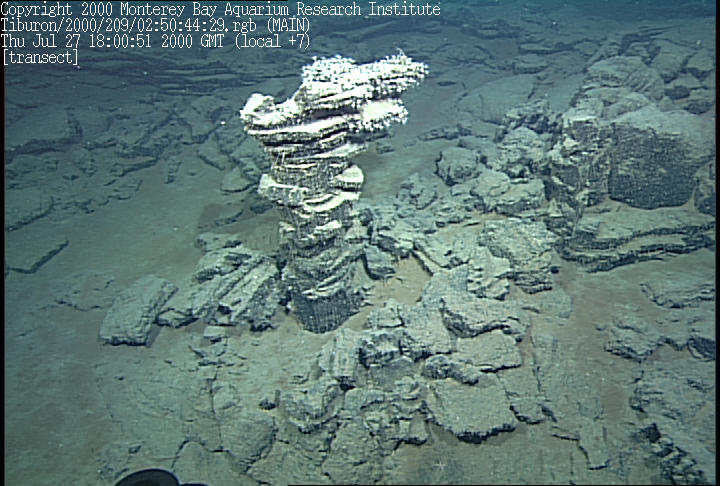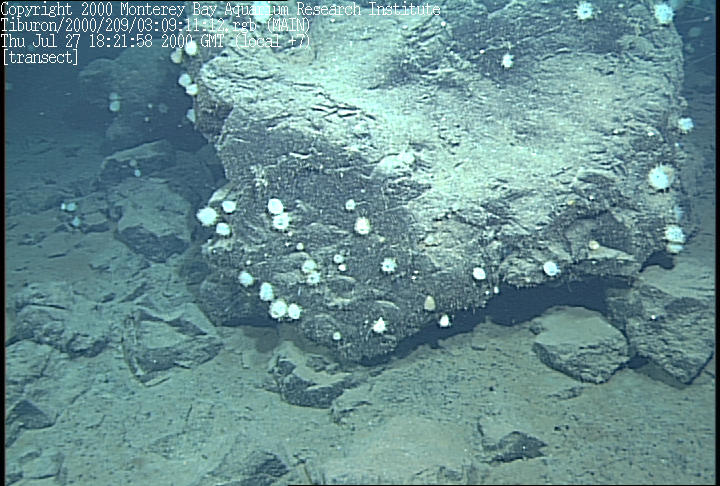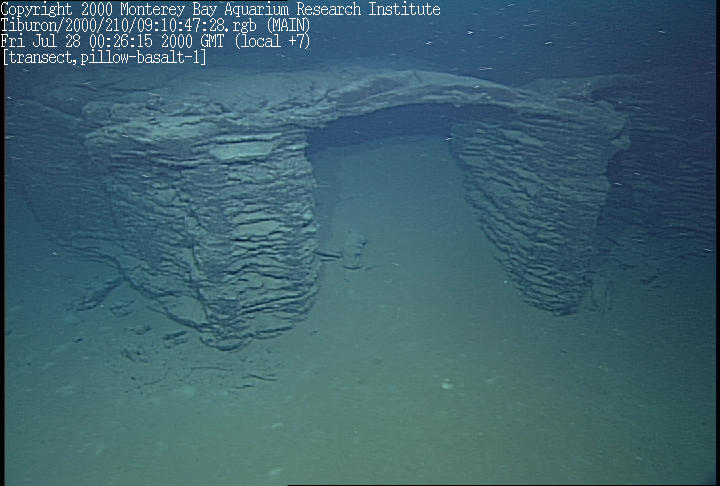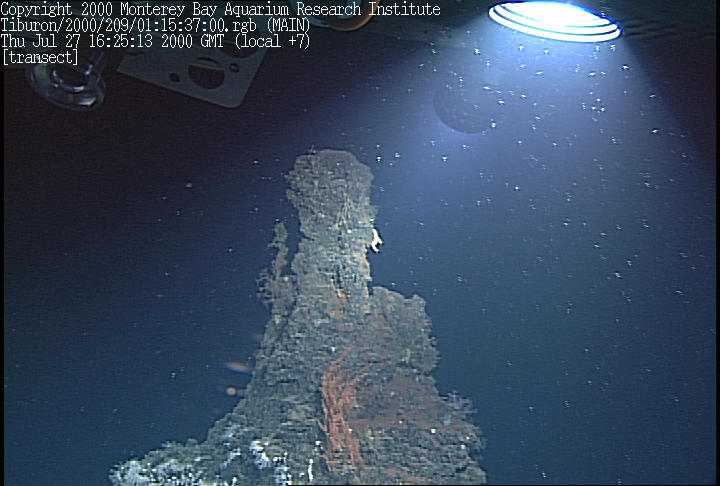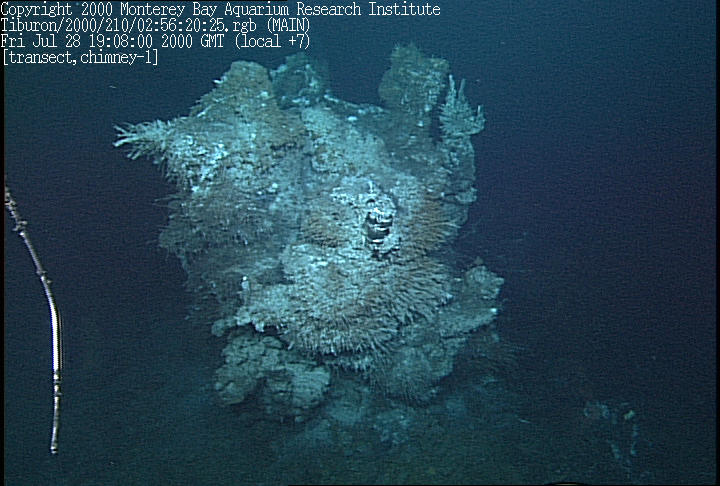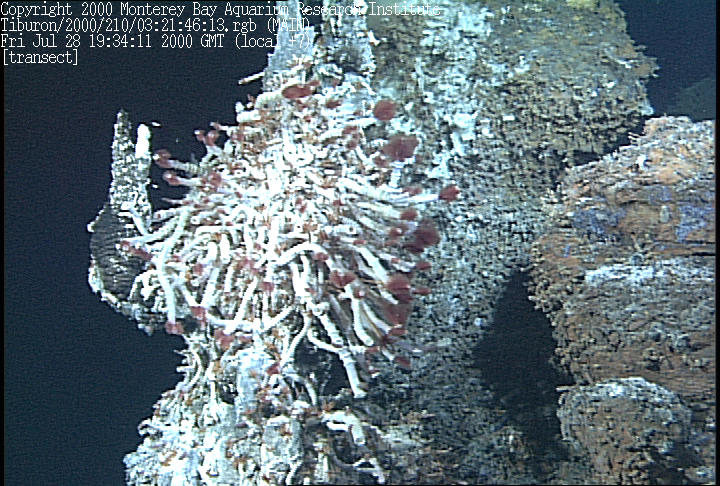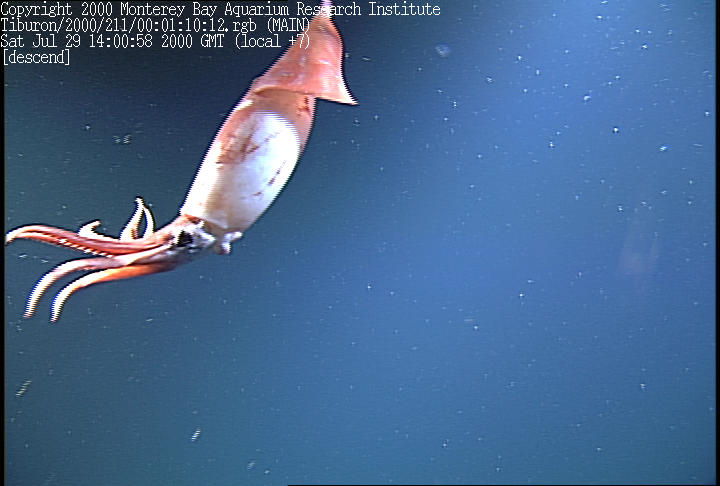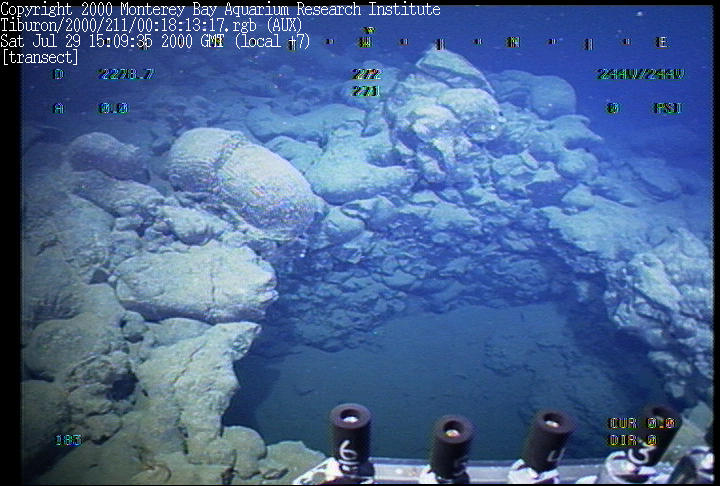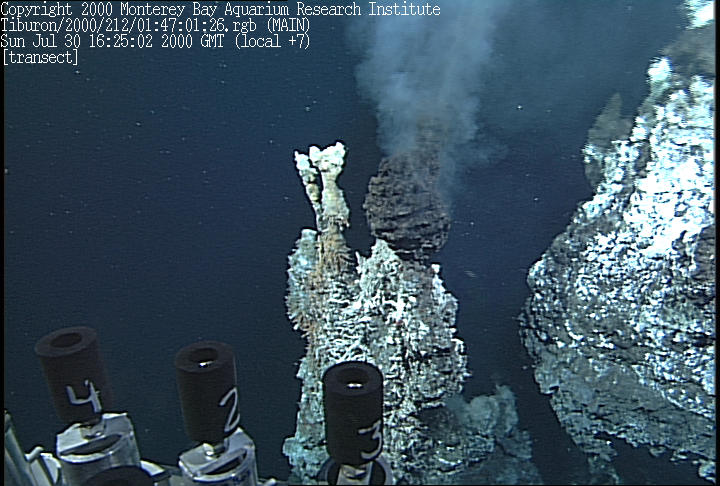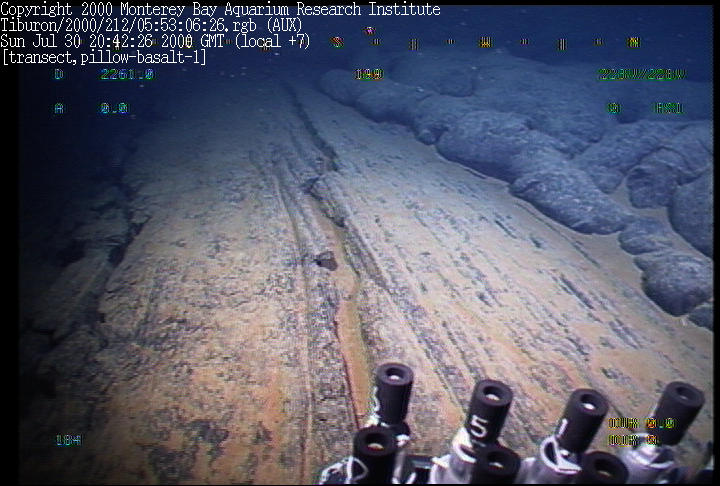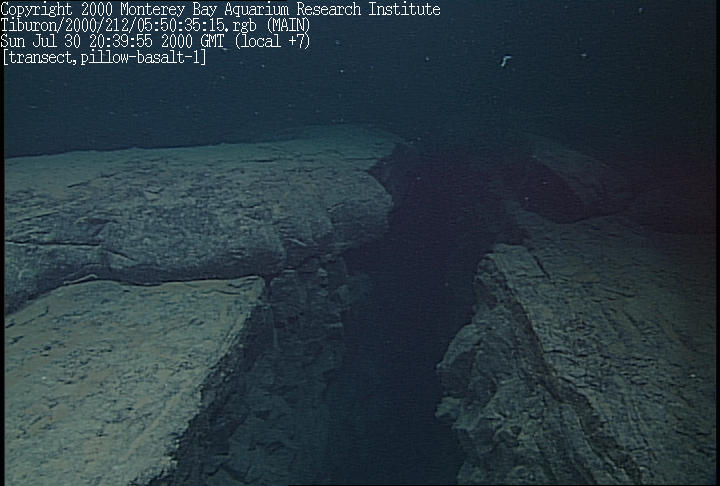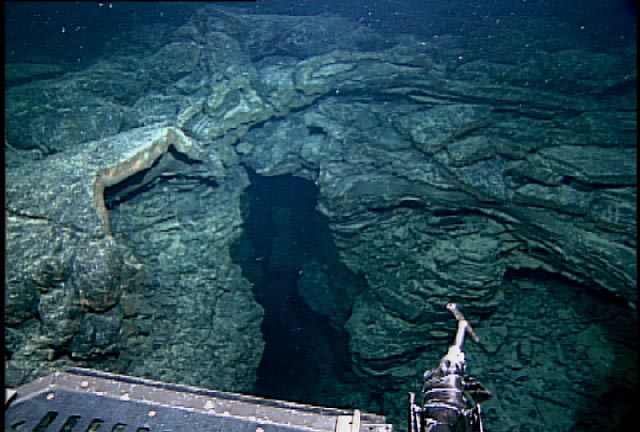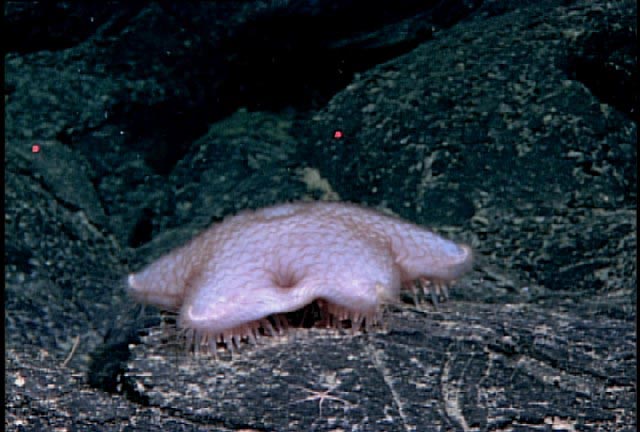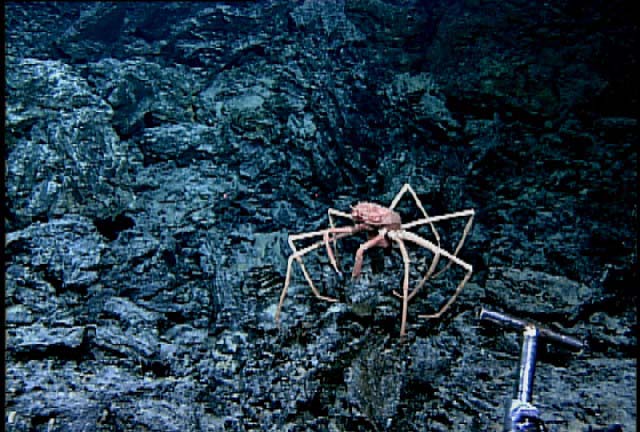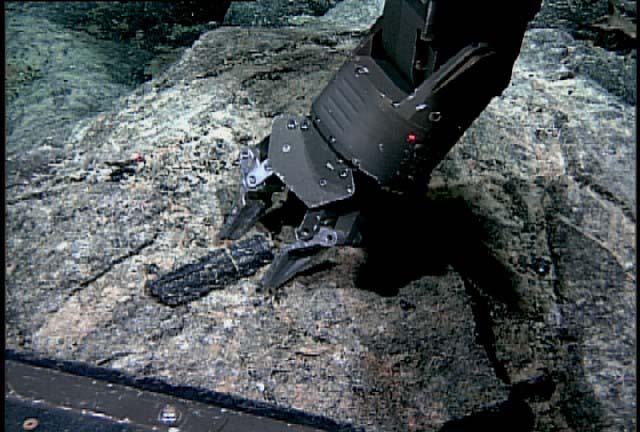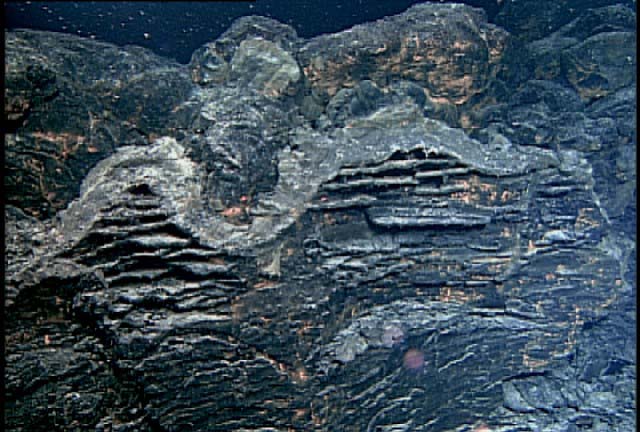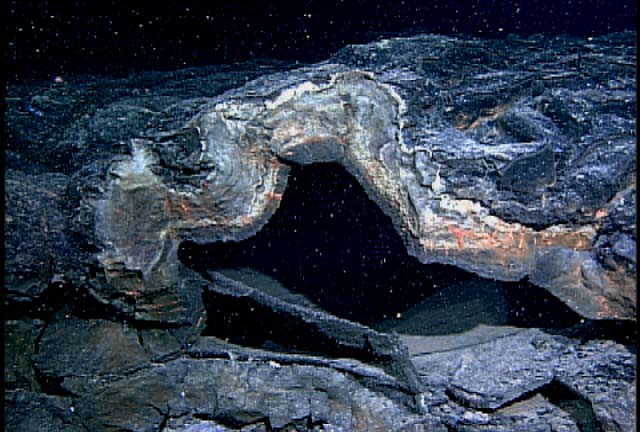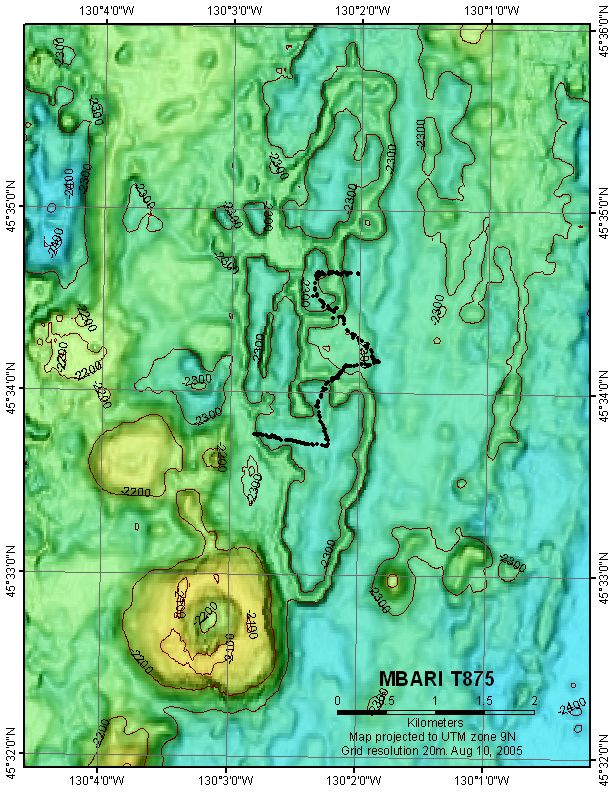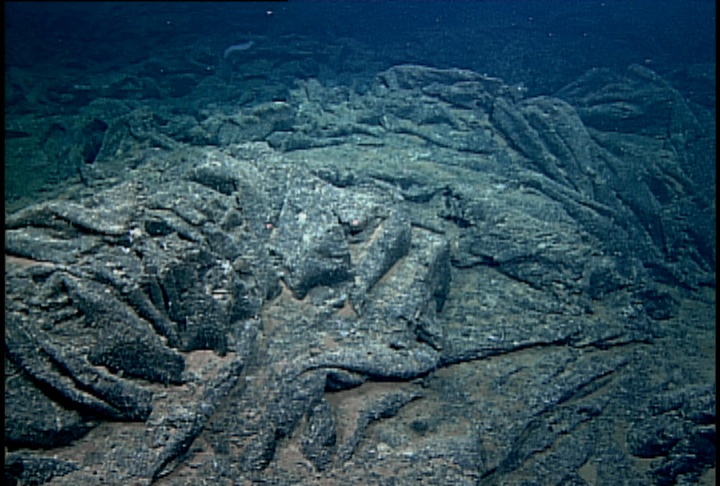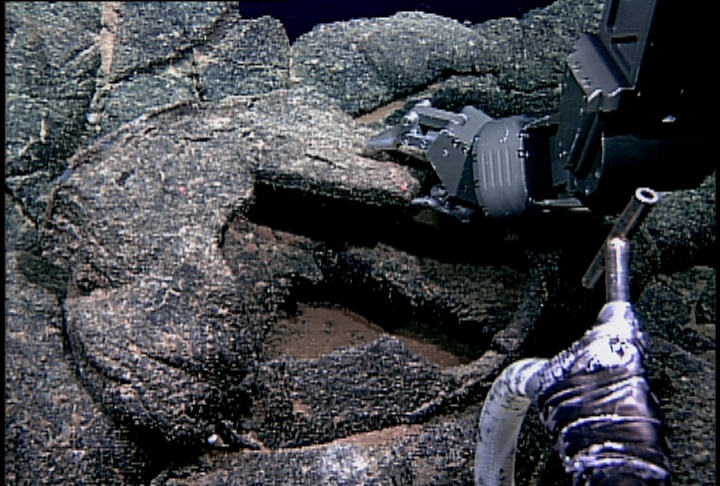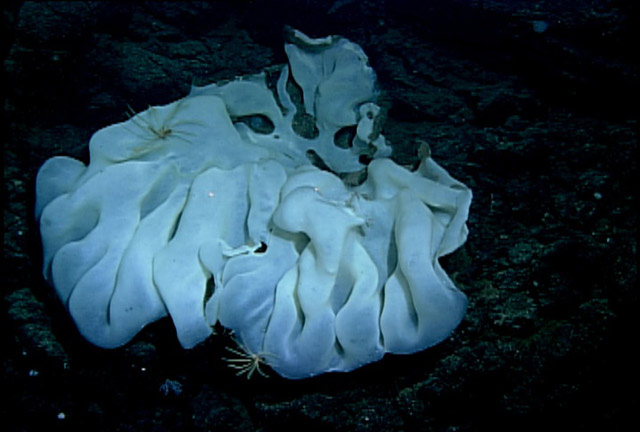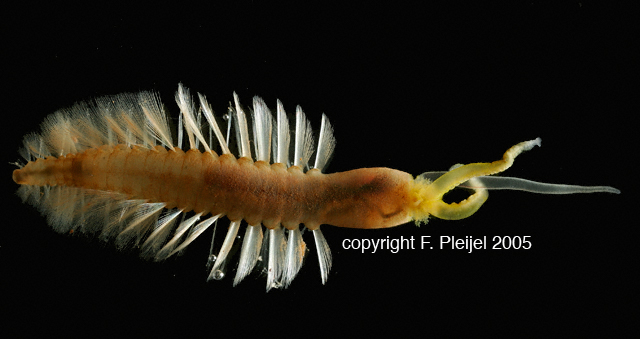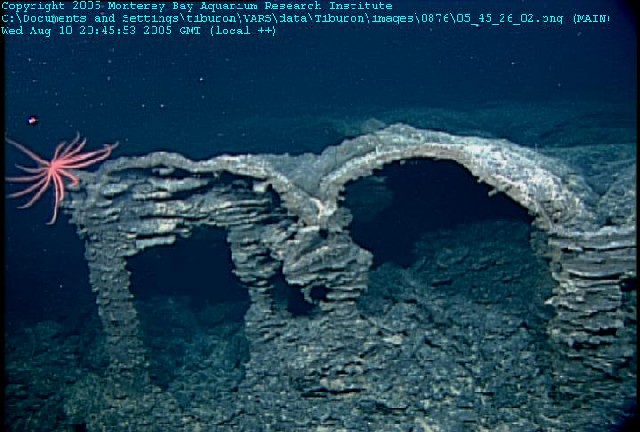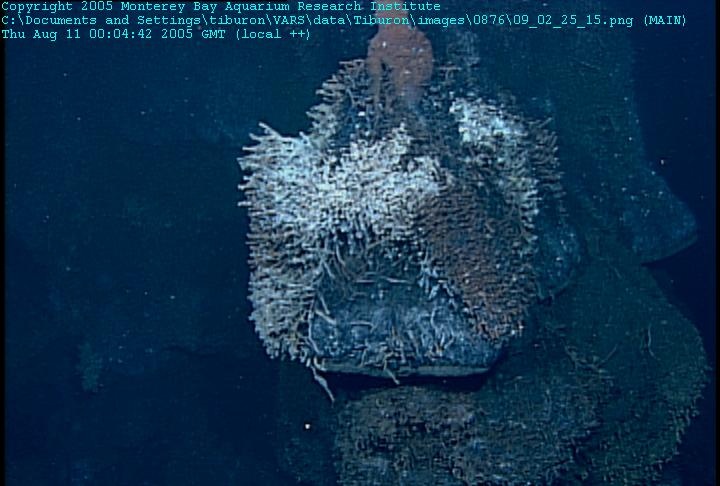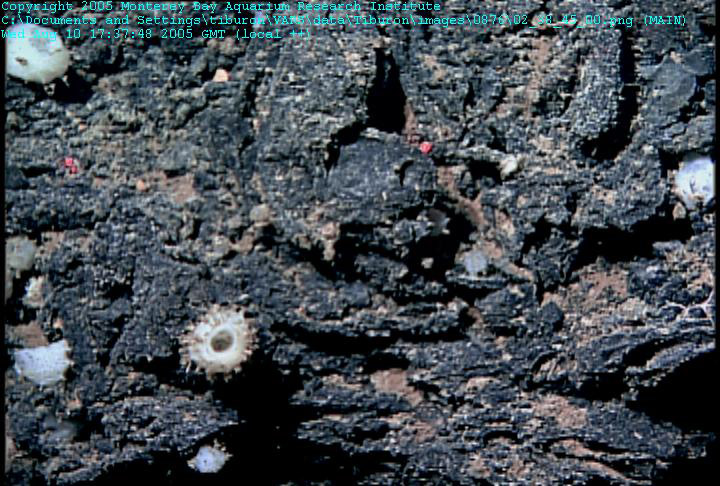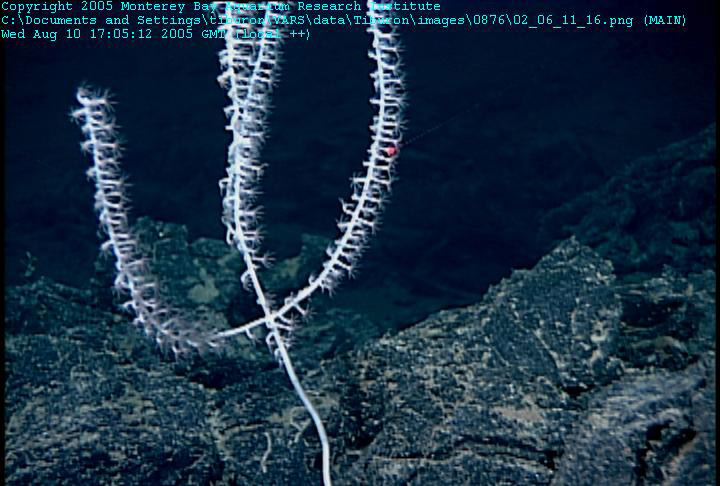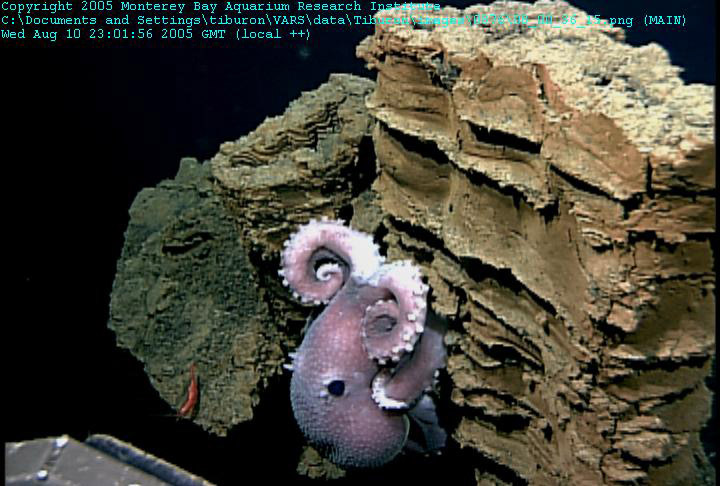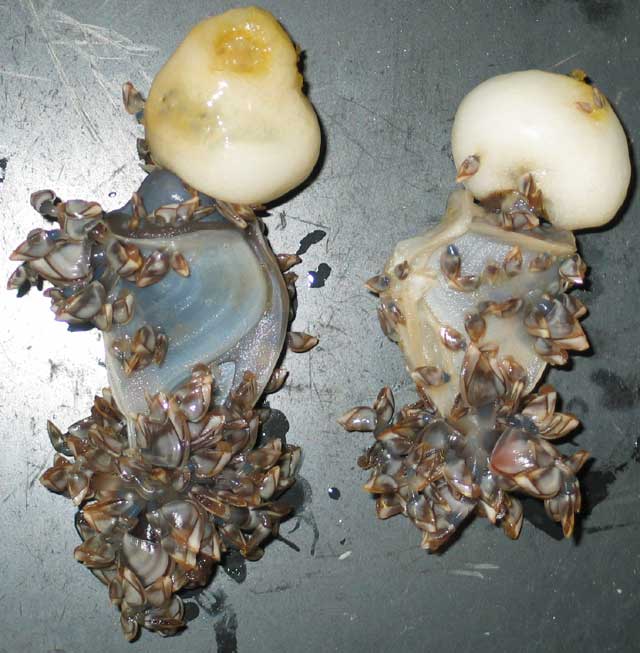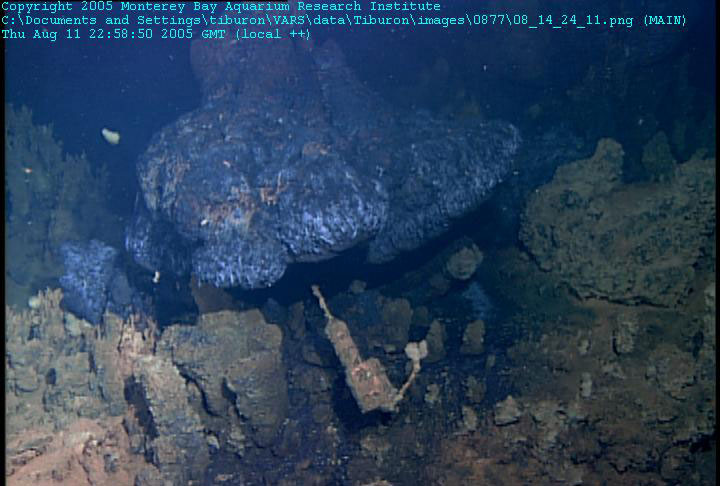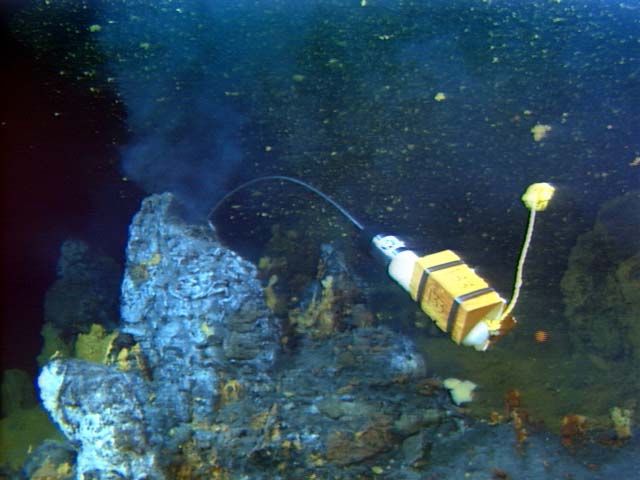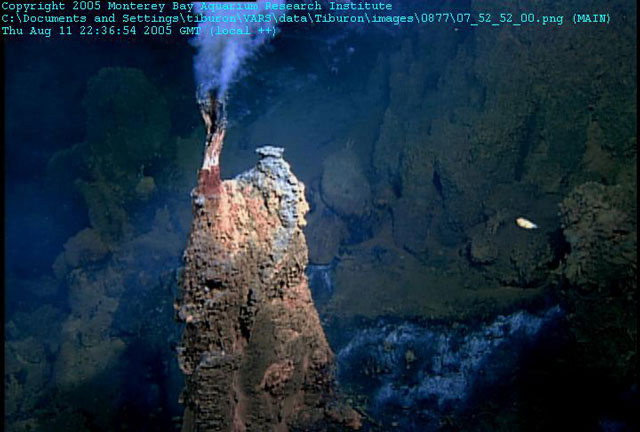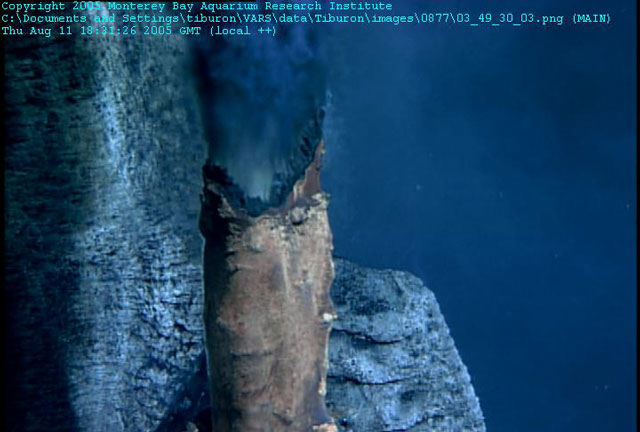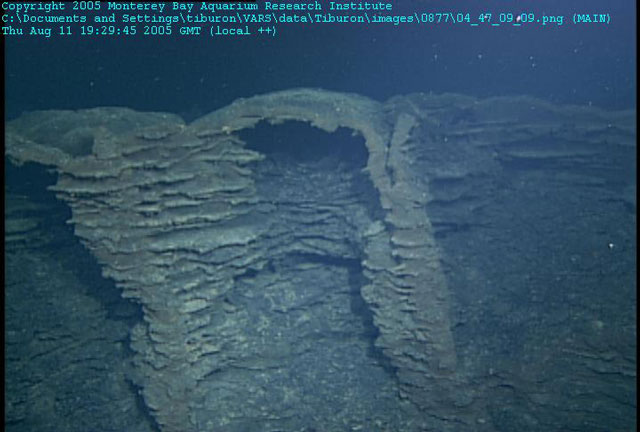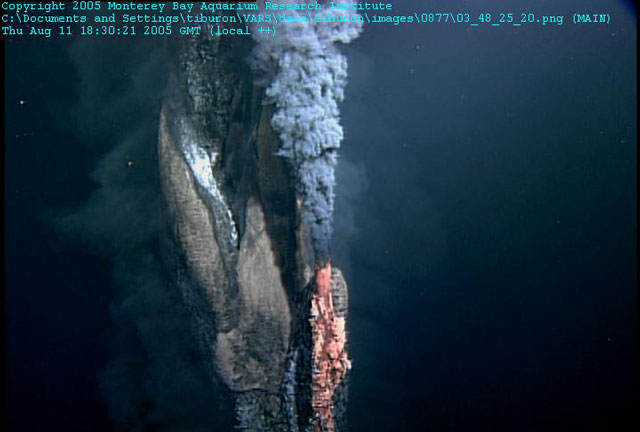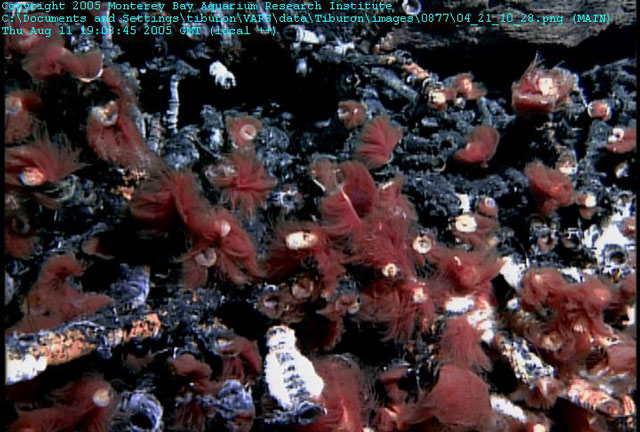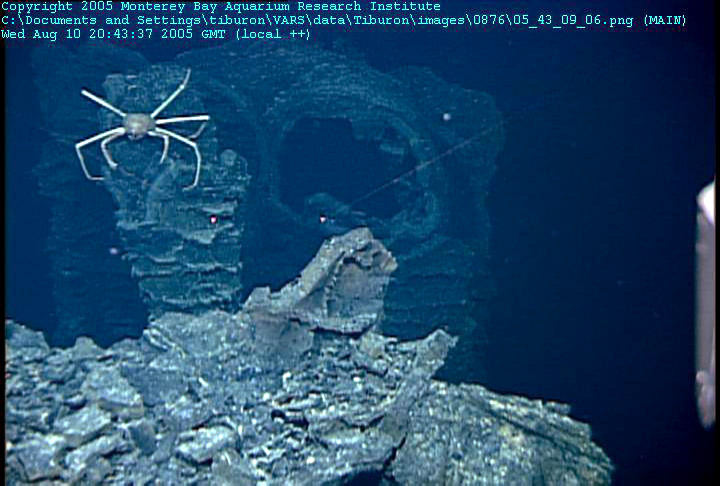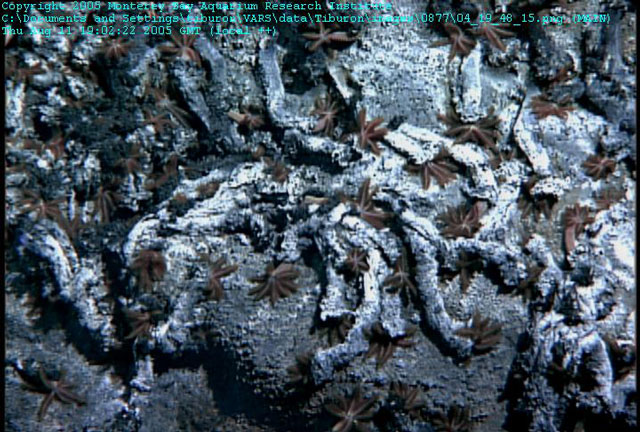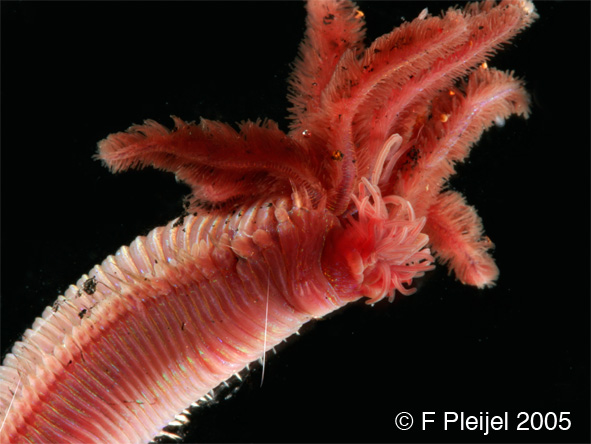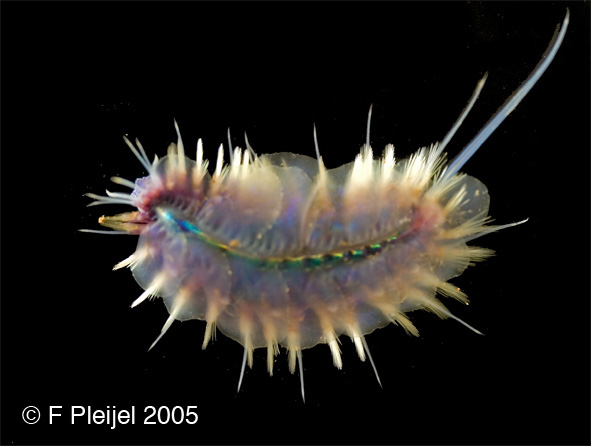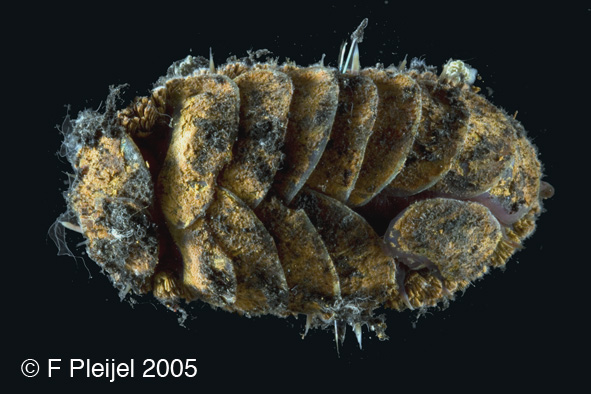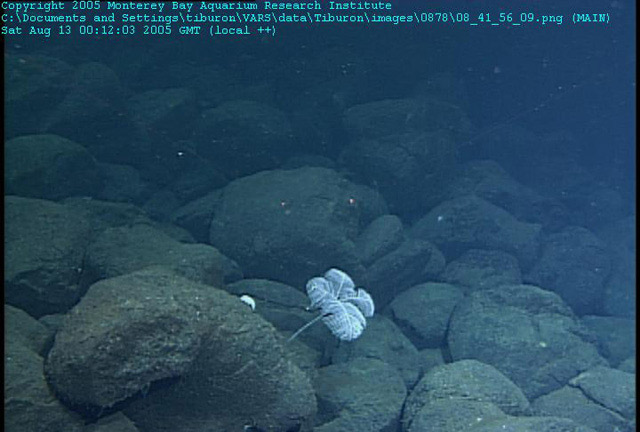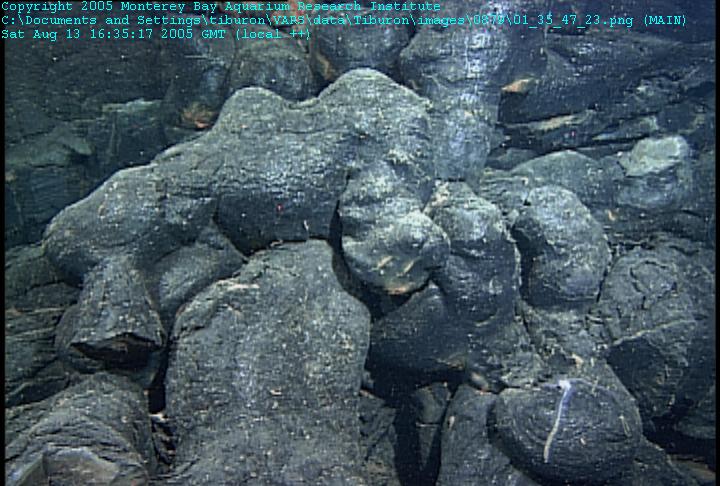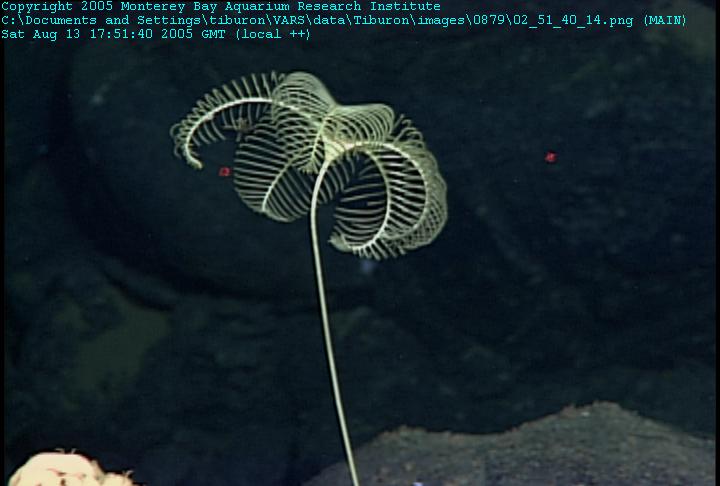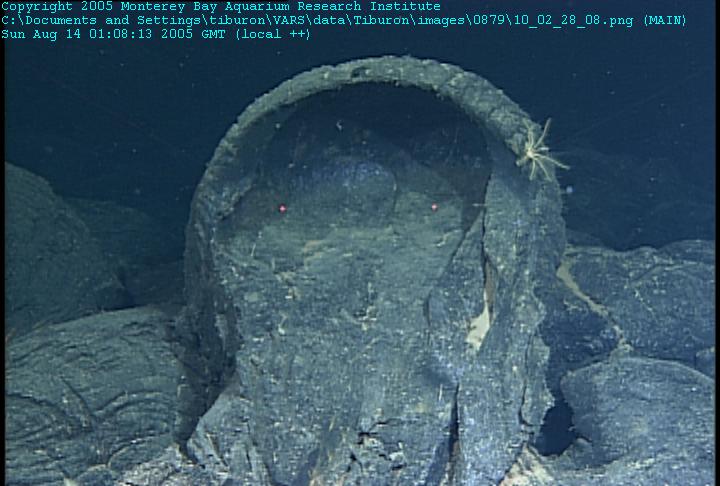 | Juan de Fuca -Over 650 km off the Washington-Oregon Coas |
Over 650 km off the Washington-Oregon Coast. These are hollow drainback features which form when lava recedes after a flow. The pillars are vents where gases were escaping |
A colony of tunicates on a rock. Similar tunicates covered the seafloor for at least five minutes |
drainback feature |
One of many deep fissures in the seafloor that passed over during transect |
extinct sulfide |
A picture of "Hell" vent, high temp (over 250 degrees C!) high temp osmosampler with high temperature HOBO recorder |
A clump of vestimentiferan worms on an outcrop |
A mesopelagic squid |
a "skylight" |
"Monolith", a high temperature hydrothermal vent. The "smoke" emerging from the vent is composed of many different minerals that are in the process of precipitating out of solution as the hot water cools upon contact with the cold seawater |
a drainback feature supported by lava columns. Notice the trademark "bathtub rings" which are an indication of the levels of the lava lake |
An off axis flow, a.k.a. the underwater "superhighway." |
A large fissure in the seafloor, edged by lava pillows |
Tiburon Dive 874, Axial 1998 South Lava Flow. Eruptive fissure. flat to slightly curved bubble-wall fragments, called limu o Pele (Peles seaweed in Hawaiian). |
few critters: sea cucumbers, a couple of crabs, and some sea stars. I was also astonished to see that although the older flows had relatively more organisms, including sponges, gorgonians, and stalked crinoids, they were still surprisingly bare of life over the area we covered. I had never thought about how long a new flow would take to be able to support larger animals. I knew that there had to be sediment and marine snow drifting down, however I had never thought about how much. The pillow lava that had sediment caught in the crevices seemed as though it could provide nutrients to larvae, and yet there were few animals on it. I would have expected many small sessile creatures, and yet the few animals we saw were pretty large, including motile ones such as crabs, cucumbers, and sea stars. |
Enormous crab walking on jumbled lava flow on the floor of a drained lava pond |
the lava morphology within the drained out area was very chaotic, indicating that the drainout had been extremely rapid, and perhaps even violent, since we found glassy spatter-like fragments (image on right)on the surface of a nearby older flow. Another intriguing aspect of this lava flow is that we know it was erupted from a fissure, because in places you can actually see the lava coming out of a crack in the ground. It is very unusual to be able to see this on the seafloor. There are also other older eruptive fissures nearby, so an extended history of similar eruptions is displayed within this small area. Another interesting aspect of the1998 lava flow is that it contains so many different lava morphologies - everything from pillow lava, lobate, ropy, lineated, and jumbled textures in a remarkably small area. These morphologies form under different conditions of supply rate and slope, and can tell us about the sequence of events during the eruption. |
Drainage shelves on the side of a fracture, with pillow lavas from a younger flow draped over the edge. |
Drained lobate flow, with a collapsed shelf inside. The shelf was the top of the flow long enough to form a crust that remained when the lava drained. The view is about a meter across. |
Map of the lava pond on the rift zone south of Axial Seamount, showing the track for ROV Tiburon dive 875. the south rift zone of Axial Seamount. The pond is simply sensational! It is actually a complex of 5 ponds separated from one another by levees that rise about 90 meters above the adjacent seafloor. The tops of all the levees are at the same depth, which suggests that all the ponds were erupted at the same time.The levees that we crossed several times consist of pillow talus and pillow lava on the outer flanks, with lobate flows on the flat levee top. The interior walls are nearly vertical cliffs, overhanging in places, of truncated lobate flows. Roughly horizontal shelves were left like bathtub rings as the lava inside the pond drained away. The pond floors are covered with talus and sheet flows. We crossed a breach in the levee and traversed a delta-like feature built from lava that flowed through the gap. The delta had a tube system that formed secondary vents on top, and these vents collapsed to form large pits. |
The ponds alone had a volume of more than 0.6 cubic kilometers. The extent and volume of the earliest sheet flows remains unknown, and will be assessed during two dives we are planning for this site later in the cruise. In any case, this was a large volume eruption relative to others at the Juan de Fuca Ridge. We do not know where the lava that drained out of the ponds went - it certainly did not simply overflow the levees since the lake drained to levels roughly 60 m below the tops of the levees. Did it drain out to erupt farther down the rift zone, as commonly occurs on Hawaiian volcanoes? One of our later dives will try to determine if this unusual lava occurs several kilometers downslope, farther south along the rift zone. Contorted, ropy sheet-flow on the floor of the pond. This type of surface occurs when the lava flows rapidly, folding the cooling crust like a crumpled rug on the floor. |
Sampling the glassy rind of a collapsed lava pillow |
Large sponge (about a meter across; the red laser dots are 30cm apart for scale), is home to two crinoids |
Flabelligerid polychaete worm collected on dive T875. It is a benthic worm that is also a good swimmer, undulating its body and using its parapodia and bristles as paddles. The worm is 4.2 cm long. |
Hydrothermal vent spouting black smoke (particles of metal sulfides) as the newly deployed temperature probe records the temperature of the fluid erupting from this side vent |
Lava pillars and arch, left behind when a shallow lava pond drained, become the perch for a large brisingid star |
Tube worms growing on a hydrothermal vent. |
Small white spongis |
Soft corals |
Octopus on a tall lava |
Barnacles suspended from a spongy float, and in turn covered by tiny gooseneck barnacles. These are floating on the sea surface out here in surprising numbers. The one on the left is about 10 cm long. |
Tiburon dive 877, South Cleft, Juan de Fuca Ridge. . The vast majority of the ocean floor is older, "abyssal plain": covered with meters, even kilometers, of sediment.included visits to some spectacular black smoker chimneys and intricate lava pillar formation. A high-temperature recorder (protruding downward in the lower center of photo) deployed in 2001, dusted with hydrothermal sediment and overgrown by a gray sulfide structure covered with alvinellid worm |
Same high-temperature probe we recovered during dive T877, back when it was deployed in 2001. Note the vigorous venting, which has now ceased, and the lack of the sulfide "cap" (photo courtesy of Bill Chadwick |
The chimneys are made from sulfide minerals coming out of the hot spring water and they seem to form impossibly tall and narrow towers. One of the chimneys we visited today was 20 meters high and another may have been venting at the boiling point of seawater at this depth (2200 m). A temperature probe at one of the chimneys recorded 340oC. All of the chimneys were covered with abundant tubeworms and other vent animals. Black smoker. Metal sulfide crystals precipitate as the hot vent fluid cools on contact with cold seawater to form the "smoke" and build the chimney. White bacterial mats are visible on the base of a larger chimney beyond |
Close-up of a black-smoker vent, which is about 10 cm across. The change from clear fluid (with the sulfides dissolved in solution) to black, "smokey" fluid (with the sulfide grains precipitating) is visible just above the vent orifice. |
extraordinary volcanic landscape along the rim of the cleft, a deep fissure at the center of the segment axial valley that has acted as an eruptive fissure for voluminous lava flows in the past. Because the cleft is so wide (~100 m) and deep (~20 m), it becomes a huge lava lake during eruptions, often overflowing the rim and feeding lava flows that flood the axial valley floor above. Then at the end of eruptions, the still molten lava drains back into the cleft, leaving a landscape of pillars and walls and drainages, that look almost like the canyonlands of the American southwest. At the end of the dive we were able to recover part of a lava pillar to investigate how these structures may record information about the dynamics of the eruption that formed them. (The work of Bill Chadwick on this cruise is being funded by the West Coast and Polar Regions Undersea Research Center |
|
Siboglonid worms on a hydrothermal chimney. The plumes are the gills of the worms, red due to hemoglobin like we have in our blood. They absorb both oxygen and sulfide, which is poisonous to us. The sulfide feeds bacterial symbionts in the worm''s tissues, which in turn feed the worm...they have no mouth or gut, and take in food no other way! |
Crab perched on a lava pillar, with more pillars topped with remains of the roof of the lava flow, beyond. The laser dots are 30cm apart for scale |
Paralvinella (alvinellid) polychaete tubeworms high up on a hydrothermal spire. Some species of these worms are known to withstand 80oC water temperatures |
Microscopic view of Paralvinella, the worm pictured on the hydrothermal vent above. The finely frilled gills (top, this image) protrude from the worm''s tube, in situ. The mouth parts are just below. The worm is about 4cm long |
Polynoid scale worms, about 3cm long. has transparent scales and more obvious chaetae, the hairs which it uses for locomotion; it was found near a lava |
Polynoid scale worms, about 3cm long. covered with bacteria, whose association with the worm is unknown; it was found near a hydrothermal vent. |
the Party Hat vent fluid collector we had deployed almost 9 years ago and recovered it and the temperature recorder attracted to it. Maybe well be able to recover the temperature record from it when we return to shore! Although there was no sign of the larger chemosynthetic fauna we were hoping to see on this dive there is a lot more to explore here and other similar places along the fracture zone and this dive was a great |
The volcanic seafloor hosted a large variety of sponges, tunicates, and soft corals like this unusual one above. The red laser dots are 30cm apart for scale |
This gorgonian (soft coral) looks very much like stalked crinoids we have seen elsewhere. It is attached to talus of pillow lava fragments |
Tiburon dive 879, North Cleft Flows, Juan de Fuca Ridge. Young lava - segment at a site that we know erupted in the mid-1980s. In fact, this was the first site in the world where we were able to document a historical eruption on the mid-ocean ridge system. Before then lots of young-looking lavas had been found, but we had no way of telling how young they were. The age of the lava flows at north Cleft could be determined because they are so thick (pillow lava ridge up to 45 m high!) that they show up as areas of significant depth change between bathymetric surveys before and after the eruption. Camera tows showed that young glassy lavas were located exactly where the depth changes were found. In addition, a giant plume of warm water, called a megaplume, was found by chance over this site in 1986, and was probably produced by the system. Before then lots of young-looking lavas had been found, but we had no way of telling how young they were. The age of the lava flows at north Cleft could be determined because they are so thick (pillow lava ridge up to 45 m high!) that they show up as areas of significant depth change between bathymetric surveys before and after the eruption. Camera tows showed that young glassy lavas were located exactly where the depth changes were found. In addition, a giant plume of warm water, called a megaplume, was found by chance over this site in 1986, and was probably produced by thesystem. Before then lots of young-looking lavas had been found, but we had no way of telling how young they were. The age of the lava flows at north Cleft could be determined because they are so thick (pillow lava ridge up to 45 m high!) that they show up as areas of significant depth change between bathymetric surveys before and after the eruption. Camera tows showed that young glassy lavas were located exactly where the depth changes were found. In addition, a giant plume of warm water, called a megaplume, was found by chance over this site in 1986, and was probably produced by the |
A stalked crinoid has already colonized the 1986 lava surface (laser dots are 30 cm apart for scale |
CoAxial segment. Montage of animals |
The crust of this pillow cracked open while lava still flowed in the tube, and it drained to form another pillow downslope. A feather star (crinoid) is clinging to the rim. It is capable of swimming. Mobile species like this can''t reliably be used to help determine the age of a flow |
Expedition of MBARI -http://www.mbari.org/expeditions/JdF2000/june16.htm
axis. The Juan de Fuca Ridge is the boundary between two plates that are spreading apart at an average rate of 6 cm/yr. Basically, one side of the ridge is moving west toward Japan, and the other side is moving eastward toward north America. However, the spreading probably takes place sporadically instead of continuously. In other words, no spreading may occur for many years, and then there is a sudden spreading event. We dont yet know how often these kinds of spreading events occur, because we have just developed the technology to measure them. That is the goal of this experimentto continuously monitor for several years at a time in order to detect and quantify spreading events
Smokers, After only four dives, this cruise has already included a lot of "firsts" for me. On dive day one, I saw really young lava flows on the sea floor for the first timeonly seven years old! Virtually no critters were living on them as yet, meaning that we did not have to scrub the rocks clean when they came on board. And all of the lavas had beautiful, chilled glassy margins on themthe result of cold seawater essentially "freezing" the molten lava before it had time to form crystals. Really cool. topography and a huge variety of lava flow types. I saw drained lava flows, lava pillars, thick piles of pillow lavas, and "superhighways" made of flat, ropy sheet lava flows. I was surprised at how quickly we flew from one volcanic flow type to the nextlava flows on the sea floor are really complicated. Dive day three was marked by my first visit to a high-temperature "black smoker" hydrothermal vent. I felt like I was watching a National Geographic video on black smokers on the East Pacific Rise, except that I was taking geology notes as Bill Chadwick was describing what we were seeing on the monitor.down the center of a mid-ocean ridge, the Pacific plate on the west side and the Juan de Fuca plate on the east side. We found a new set of hydrothermal chimneys that had not been documented before, one of which was over twenty meters high. It''s amazing that these thin hydrothermal chimneys can stay standing up when they get to be that tall! So what''s in store for us for the next seven days? We don''t know for sure, but I''ll bet it will be fun and include more "firsts".
today! Black smokers are a type of hydrothermal vent that typically emit metal sulphides. When sea water percolates through cracks in the ocean crust near the mid-ocean ridge, it gets heated, and dissolves minerals in the rocks as it passes by. When enough pressure builds up, this water with the dissolved minerals escapes at these vents. The moment it reaches the cold seawater, it becomes oversaturated and the dissolved minerals precipitate instantaneously. We could actually see this transition occurring where the clear water from the vent became black as the minerals formed! To see something like this occurring right before my eyes was absolutely A-M-A-Z-I-N-G. I also found it interesting how the abundance of life on these hydrothermal vents is a rough indication of temperature. Some were too hot for "critters" to be living on them, whereas others that were "cooler" had a lot of life on them. I was also surprised at the size of the tube worms.... the animals were up to 40cm long and the tubes in which they live were over twice that length.
Tiburon dive 879, North Cleft Flows, Juan de Fuca Ridge.end of the Cleft segment at a site that we know erupted in the mid-1980s. In fact, this was the first site in the world where we were able to document a historical eruption on the mid-ocean ridge system. Before then lots of young-looking lavas had been found, but we had no way of telling how young they were. The age of the lava flows at north Cleft could be determined because they are so thick (pillow lava ridge up to 45 m high!) that they show up as areas of significant depth change between bathymetric surveys before and after the eruption. Camera tows showed that young glassy lavas were located exactly where the depth changes were found. In addition, a giant plume of warm water, called a megaplume, was found by chance over this site in 1986, and was probably produced by the eruption.
flow. In a few days, we will visit another historical lava flow that erupted in 1993 on the CoAxial segment, and this may help us to further refine the pattern and rate of biological colonization on young lava
Next
Juan de Fuca Ridge Volcanics Juan de Fuca Ridge - Gorda Ridge - Axial Seamount
take text
